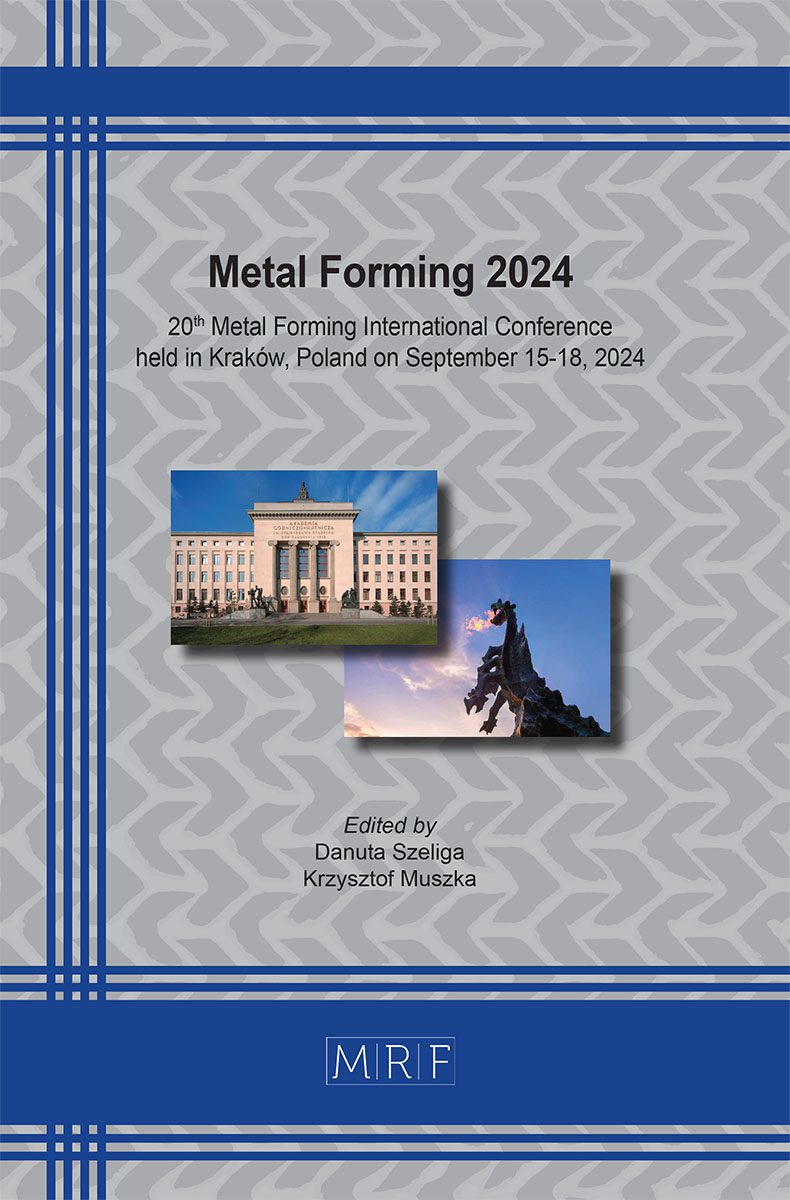–
Hole expansion performance of a medium manganese advanced high-strength steel after hot rolling and intercritical annealing
PLOSILA Pekka, KANTANEN Pekka, HANNULA Jaakko, JAVAHERI Vahid, KÖMI Jukka, KAIJALAINEN Antti
download PDFAbstract. This paper investigates the hole expansion behavior of a medium manganese advanced high-strength steel. The study began with vacuum-cast 0.3C–1Si–6Mn–2Al steel, which was subsequently laboratory hot-rolled to a thickness of 4 mm. Intercritical annealing treatments (IAT) were then carried out at temperatures of 650 °C and 700 °C to produce varying fractions of tempered martensite/ferrite and retained austenite (RA). Tensile tests were performed in the longitudinal direction, while hole expansion tests following ISO 16630 were conducted to assess the stretch-flangeability of the IAT materials. Test holes were prepared using punching and wire electrical discharge machining (W-EDM) to examine the effects of different edge conditions. Tensile strength of 1027 MPa and 911 MPa corresponding to a microstructure consisting of RA fraction of 7.5% and 43.3% were obtained at IA temperatures of 650 °C and 700 °C, respectively. Mean hole expansion ratios (HER) with punched holes were relatively low for the given strength levels (3% and 17% for IAT 650 °C and IAT 700 °C, respectively). W-EDM edge condition considerably improved HER but not as much as expected, potentially due to the high inhomogeneity of the microstructure. Further research on optimization of processing and microstructure is required to enhance the poor hole expansion performance of intercritically annealed medium manganese steels.
Keywords
Medium Manganese Steel, Annealing, Retained Austenite, Formability, Stretch-Flangeability
Published online 9/15/2024, 10 pages
Copyright © 2024 by the author(s)
Published under license by Materials Research Forum LLC., Millersville PA, USA
Citation: PLOSILA Pekka, KANTANEN Pekka, HANNULA Jaakko, JAVAHERI Vahid, KÖMI Jukka, KAIJALAINEN Antti, Hole expansion performance of a medium manganese advanced high-strength steel after hot rolling and intercritical annealing, Materials Research Proceedings, Vol. 44, pp 358-367, 2024
DOI: https://doi.org/10.21741/9781644903254-38
The article was published as article 38 of the book Metal Forming 2024
![]() Content from this work may be used under the terms of the Creative Commons Attribution 3.0 license. Any further distribution of this work must maintain attribution to the author(s) and the title of the work, journal citation and DOI.
Content from this work may be used under the terms of the Creative Commons Attribution 3.0 license. Any further distribution of this work must maintain attribution to the author(s) and the title of the work, journal citation and DOI.
References
[1] B.S. Levy, C.J. Van Tyne, Review of the shearing process for sheet steels and its effect on sheared-edge stretching, J. Mater. Eng. Perform. 21 (2012) 1205–1213. https://doi.org/10.1007/s11665-011-9997-x
[2] International Organization for Standardization, ISO 16630:2017 Metallic materials – Sheet and strip – Hole expanding test, (2017)
[3] P. Larour, J. Hinterdorfer, L. Wagner, J. Freudenthaler, A. Grünsteidl, M. Kerschbaum, Stretch flangeability of AHSS automotive grades versus cutting tool clearance, wear, angle and radial strain gradients, IOP Conf. Ser. Mater. Sci. Eng. 1238 (2022) 012041. https://doi.org/10.1088/1757-899x/1238/1/012041
[4] A. Karelova, C. Krempaszky, E. Werner, P. Tsipouridis, T. Hebesberger, A. Pichler, Hole expansion of dual-phase and complex-phase AHS steels – Effect of edge conditions, Steel Res. Int. 80 (2009) 71–77. https://doi.org/10.2374/SRI08SP110
[5] W. Cho, B.S. Jeong, K. Jeong, S.H. Lee, H. Kim, J. Lee, S. Kim, H.N. Han, New approach to hole-expansion ratio in complex phase and martensitic steels: Understanding the role of punching damage, J. Mat. Res. Tech. 26 (2023) 837–849. https://doi.org/10.1016/j.jmrt.2023.07.253
[6] J.H. Kim, E.J. Seo, M.-H. Kwon, S. Kang, B.C. De Cooman, Effect of quenching temperature on stretch flangeability of a medium Mn steel processed by quenching and partitioning, Mat. Sci. Eng. A 729 (2018) 276-284. https://doi.org/10.1016/j.msea.2018.05.083
[7] Y.-R. Im, E.-Y. Kim, T. Song, J.S. Lee, D.-W. Suh, Tensile Properties and Stretch-Flangeability of TRIP Steels Produced by Quenching and Partitioning (Q&P) Process with Different Fractions of Constituent Phases, ISIJ Int. 61 (2021) 572-581. https://doi.org/10.2355/isijinternational.ISIJINT-2020-388
[8] N. Fonstein, Advanced High Strength Sheet Steels, first ed., Springer International Publishing, Cham, 2015, XXII 396. https://doi.org/10.1007/978-3-319-19165-2
[9] S. Lee, S.-J. Lee, B.C. De Cooman, Austenite stability of ultrafine-grained transformation induced plasticity steel with Mn partitioning, Scr. Mater. 65 (2011) 225-228. https://doi.org/10.1016/j.scriptamat.2011.04.010
[10] P. Kantanen, S. Anttila, P. Karjalainen, R. Latypova, M. Somani, A. Kaijalainen, J. Kömi, Microstructures and mechanical properties of three medium-Mn steels processed via quenching and partitioning as well as austenite reversion heat treatments, Mater. Sci. Eng. A 847 (2022) 143341. https://doi.org/10.1016/j.msea.2022.143341
[11] International Organization for Standardization, EN ISO 6892-1:2019 Metallic materials. Tensile testing. Part 1: Method of test at room temperature, (2019)
[12] VDA 238-110. Verband der Automobilindustrie e. V., VDA 238-110 Ermittlung der Lokalen Duktilität aus der Bruchfläche von Zugproben / Determination of Local Ductility by Fracture Surface Analyses of Tensile Test Specimens 08/2023, (2023)












